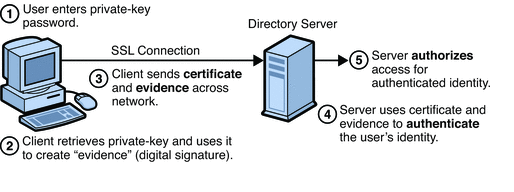Introduction to Certificate-based Authentication
Figure 5–2 shows how certificates and the SSL protocol are used together for authentication. To authenticate a user to a server, a client digitally signs a randomly generated piece of data and sends both the certificate and the signed data across the network. For the purposes of this discussion, the digital signature associated with some data can be thought of as evidence provided by the client to the server. The server authenticates the user’s identity on the strength of this evidence.
Like for password-based authentication illustrated in Figure 5–1, Figure 5–2 assumes that the user has already decided to trust the server and has requested a resource. The server has requested client authentication in the process of evaluating whether to grant access to the requested resource.
Figure 5–2 Certificate-Based Authentication

Unlike for password-based authentication illustrated in Figure 5–1, Figure 5–2 requires the use of SSL. In Figure 5–2 it is assumed that the client has a valid certificate that can be used to identify the client to the server.
Certificate-based authentication is generally considered preferable to password-based authentication because it is based on what the user has, the private key, as well as what the user knows, the password that protects the private key. However, it’s important to note that these two assumptions are true only if unauthorized personnel have not gained access to the user’s machine or password, the password for the client software’s private key database has been set, and the software is set up to request the password at reasonably frequent intervals.
Note –
Neither password-based authentication nor certificate-based authentication address security issues related to physical access to individual machines or passwords. Public-key cryptography can only verify that a private key used to sign some data corresponds to the public key in a certificate. It is the user’s responsibility to protect a machine’s physical security and to keep the private-key password secret.
Certificates replace the authentication portion of the interaction between the client and the server. Instead of requiring a user to send passwords across the network throughout the day, single sign-on requires the user to enter the private-key database password just once, without sending it across the network. For the rest of the session, the client presents the user’s certificate to authenticate the user to each new server it encounters. Existing authorization mechanisms based on the authenticated user identity are not affected.
- © 2010, Oracle Corporation and/or its affiliates
